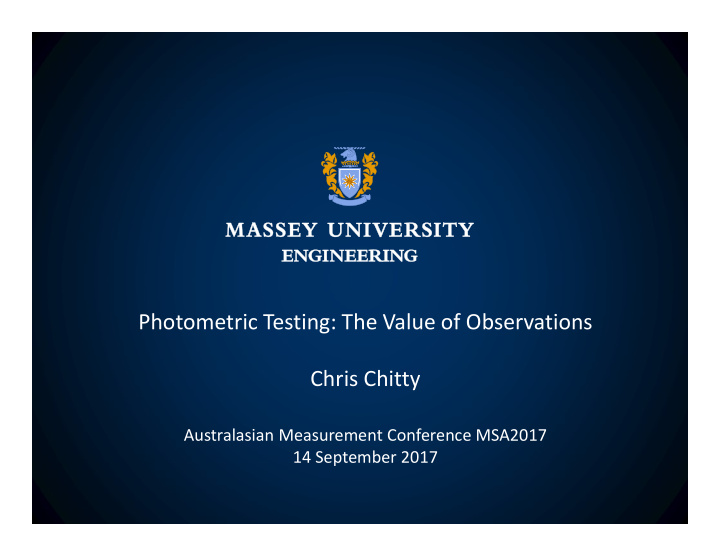



Photometric Testing: The Value of Observations Chris Chitty Australasian Measurement Conference MSA2017 14 September 2017
Introduction LED • Energy Efficient • Wide range of uses • Many manufacturers • Quality
LED vs Incandescent Incandescent LED • 1,000 hours • 15,000 to 25,000 hours Could residential customers become victims of an inappropriate long term lighting solution?
LED vs Incandescent Incandescent LED • Well-established • Under development • Heated wire • Electronic componentry • Output proportional to • Output depends on power electronics • Trusted • Much to be learnt How can superior products be identified?
Experimental Setup • Six years • Over 200 residential lamps • Identify superior products by comparing their photometric performance to quality standards By-products of photometric testing give a new understanding of LED behaviour.
Experimental Setup Incandescent LED GLS R80 GU10 MR16
Experimental Setup • “Warm white” (2700K-3000K) • Many lamp brands • Batches of three
Experimental Setup • Lamps photometrically tested at initiation of each project • Tests to follow included: – rapid-cycle stress testing – operation in a standard downlight for 6,000 hours – long-term operation in free air for 10,000 hours • Lamps mounted in standard operating positions for all long-term investigations
Experimental Setup Video Screen 1.5m diameter Sensing SPR-600M Integrating Sphere with SL-300 Spectroradiometer
Experimental Setup • Spectral power distribution • Correlated Colour Temperature (CCT) • Duv • Colour Rendering Index (CRI) • R 9 • Luminous Efficacy • Power • Power Factor • Current
Findings - Stabilisation Incandescent LED • Short time to reach • Some products made an stable output excellent transition from pre-burn, but others performed poorly in this area. Will the consumer’s expectations of stable light output soon after turn-on be realised?
Findings - Flicker Video Screen Integrating Sphere
Findings - Flicker LED Type 1
Findings - Flicker LED Type 2
Findings - Flicker LED Type 3
Findings - Flicker LED Type 4
Findings - Flicker Compact Fluorescent
Findings - Flicker Incandescent
E4 E5 E6 10,000HRS
A4 10,000HRS B6 B4
GROUP F 400
TREE F 400
BUNCH F 1000
TREE F 1000
Findings - Flicker Incandescent LED • Flicker precautions not • Potential for stroboscopic required effects More research in this area is vital.
Findings – Heat Degradation Incandescent LED • Known to generate • Commonly touted as heat being cool Product designers need to choose materials suitable for purpose.
Findings – Heat Degradation Crack
Findings – Component Failure Incandescent LED • Simple tungsten wire • Can be complex in design produces illuminance LEDs are only as strong as their weakest component.
Findings – Component Failure
Findings – Component Failure • Example 1: MR16 Replacement Lamps – burning smell after 1,000 hours in downlights – similar behaviour in free air after 3,000 hours – rated for 25,000 hours – fire risk – possibility of toxic gases and fumes
Findings – Component Failure • Example 2: GLS Replacement Lamps – failure in free air after 665 hours, 1240 hours and 1335 ours – rated for 30,000 hours – driver electronics had failed – had passed ENERGY STAR until this point – photometric data used in isolation may not be a sufficient demonstration of a quality product
Conclusions • Useful by-products arise from photometric testing • Some issues are immediate, others become apparent over time • Independent testing and observation is vital to ensure that poor performing products are removed from circulation
References • AS/NZS1680.1: Interior and workplace lighting, Part 1: General principles and recommendations, 2006. • Bodart M, Roisin B, D’Herdt P, Keppens A, Hanselaer P, Ryckaert W R, Arnaud D G, “Performances of Compact Fluorescent Lamps with Integrated Ballasts and Comparison with Incandescent Lamps”, Light & Engineering, 18:2, 83-98, 2010. • Chen W, Ron Hui S Y, “Elimination of an Electrolytic Capacitor in AC/DC Light-Emitting Diode (LED) Driver With High Input Power Factor and Constant Output Current”, IEEE Transactions on Power Electronics, 27:3 , 1598-1607, 2012. • DiLaura D L, “Farewell to the Incandescent Lamp: A Retrospective to Recount, Assess, and Honor a Passing Technology”, LEUKOS, 5:3 , 183-235, 2009. • ENERGY STAR, Energy Star program requirements for integral LED lamps, https://www.energystar.gov/ia/partners/product_specs/program_reqs/Integral_LED_Lamps_Program_Re quirements.pdf • European Commission, Preliminary Opinion on Potential Risks to Human Health of Light Emitting Diodes (LEDs), https://ec.europa.eu/health/sites/health/files/scientific_committees/scheer/docs/scheer_o_011.pdf • IES LM-79-08: Approved Method: Electrical and Photometric Measurements of Solid-State Lighting Products, 2008. • IES TM-28-14: Projecting Long-Term Luminous Flux Maintenance of LED Lamps and Luminaires, 2014. • Jaén M, Sandoval J, Colombo E & Troscianko T, “Officer Workers Visual Performance and Temporal Modulation of Fluorescent Lighting”, LEUKOS, 1:4, 27-46, 2005.
Recommend
More recommend